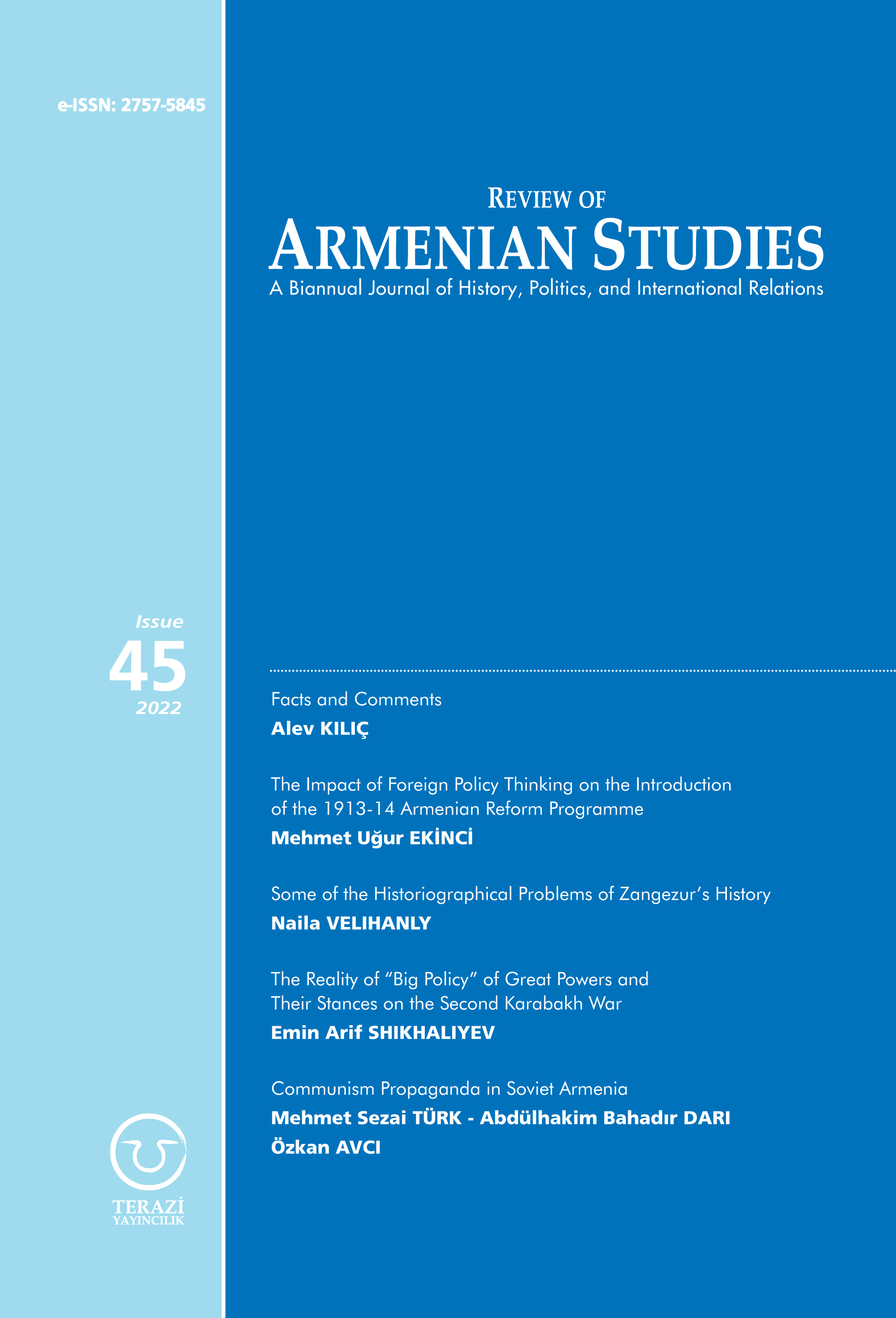Download PDF :


The newly published 45th issue of the Review of Armenian Studies journal contains 5 articles.
The first article in the 45th issue, titled “Facts and Comments” and authored by Alev Kılıç, covers Turkey-Armenia relations as well as internal and international developments of Armenia in the period of January-June 2022. The Second Karabakh War led to a substantial change in the region, opening new horizons for establishing peace, stability, cooperation, and neighborly relations in the region. The first step to activate this regional potential will be the signing of the Peace Treaty between Armenia and Azerbaijan, but no concrete development could be achieved during this period. Meanwhile, the peace treaty process with Azerbaijan caused heated arguments in internal politics in Armenia. In this process, the EU tried to fill the void left by the ineffective OSCE Minsk Group co-chair system, which is favored by Armenia but causes discomfort for Russia. Another development has been the initiation of a normalization process between Turkey and Armenia, with both sides designating special representatives for negotiations. The special representatives met three times, but Turkey’s insistence on holding the talks directly in respective capitals could not be realized due to Armenia’s preference to conduct them with a third-party involvement. The proposal promulgated by the Turkish and Azerbaijani Presidents to establish a regional platform of six countries (receiving cool reaction from non-regional parties), convened for its first meeting with one absentee, Georgia, on political bilateral differences with Russia. The month of April was again an occasion to bring into agenda the unfounded Armenian narrative and allegations, with the US administration again going to the extremes in this regard. This narrative and allegations used by the West reveal that they are regarded as a political tool to exert political pressure on Turkey.
In his article titled “The Impact of Foreign Policy Thinking on the Introduction of the 1913-14 Armenian Reform Programme”, Mehmet Uğur Ekinci elucidates how the Ottoman Empire’s decision-making elite approached the Armenian reform question in the aftermath of the Young Turk revolution and demonstrates how foreign political considerations shaped the introduction of the 1913-14 reform program known as the “Eastern Anatolian Reforms.” The Ottoman decision-makers prioritized safeguarding the Empire’s external security and international position over satisfying the reform demands of the Ottoman Armenians. Thus, Ekinci argues, Ottoman foreign policy calculations significantly affected the solutions developed for an internal problem, and, moreover, internal reform was used as a foreign policy tool.
In her article titled “Some of the Historiographical Problems of Zangezur’s History”, Naila Velihanly seeks to expose the falsifications and invalidity of the theories concerning the history of Zangezur of the 7-12th centuries geared towards proving that the region is an ancient Armenian land. For this, Velihanly refers to numerous primary sources and historical facts to explain that Zangezur was, in fact, the land of Caucasian Albania that witnessed many changes in ethnic makeup and political rule. Because Zangezur is a strategic region that today makes up the southern territory of Armenia and separates the main territory of Azerbaijan from the Azerbaijani exclave of Nakhchivan, the debate over its history still has ramifications for the South Caucasus today.
In his article titled “The Reality of ‘Big Policy’ of Great Powers and their Stances on the Second Karabakh War”, Emin Arif Shikhaliyev narrates the sequence of key events that led to the outbreak of the Second Karabakh War, what factors shaped to position of the relevant actors in this conflict, and how the outcome of the war affected these relevant actors. Shikhaliyev explains that South Caucasus may be considered a geopolitical “stage for wolves” whereby all countries claiming hegemony and regional states are seeking to assert themselves. Shikhaliyev warns that, although the war ended in Azerbaijan’s victory in the battlefield, the war nevertheless continues in the political, diplomatic and information realm. In this regard, the alliance between Azerbaijan and Turkey will play a key role in safeguarding their rights and allowing them to prevent other actors such as Armenia, Russia, or France from undermining their position in the South Caucasus.
In their article titled “Communism Propaganda in Soviet Armenia”, Mehmet Sezai Türk, Abdülhakim Bahadır Darı, and Özkan Avcı analyzes a select number of Soviet propaganda posters that were meant to legitimize the communist regime in the Armenian Soviet Socialist Republic. The authors explain that the Soviet administration used discourses that glorified the ideology of communism through the mass media it dominated, and in this way, it aimed for the peoples of the Soviet Union to embrace communism and implement the decisions taken by the regime without question. In this endeavor, it seems that propaganda posters were one of the preferred mediums to propagate the Soviet administration’s messages. By using the semiotics method, the authors reveal that the posters gave the message that communism played a leading role in the construction of a modern and prosperous Armenia, and at the same time, that the Armenian people were loyal to the communist ideology.
To access the 45th issue, please click: https://avim.org.tr/en/Dergi/Review-Of-Armenian-Studies/45
To access the website of the Review of Armenian Studies, please click: https://avim.org.tr/en/Dergiler/Review-Of-Armenian-Studies





























